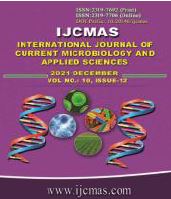


 National Academy of Agricultural Sciences (NAAS)
National Academy of Agricultural Sciences (NAAS)

|
PRINT ISSN : 2319-7692
Online ISSN : 2319-7706 Issues : 12 per year Publisher : Excellent Publishers Email : editorijcmas@gmail.com / submit@ijcmas.com Editor-in-chief: Dr.M.Prakash Index Copernicus ICV 2018: 95.39 NAAS RATING 2020: 5.38 |
The exploration and survey for diversity of threatened of ethno-medicinal plant species in West Khasi Hills District of Meghalaya was conducted during 2020-2021 for 15 villages in Byrki, Pyndensohphoh, Pyndenmawbah, Marshan, Thangkhmahjah, Nongkhlaw, Nongkynjang, Nonglwai-I, Nonglwai-II, Mawthungkper, Jaidoh, Nongklung Rim, Nongklung, Marskuin and Nongjyllieh. The methodology followed the quantitative analysis and use of phytosociological aspects between the species. Quadrate size 100m2 for trees, 50m2 for shrubs and 10m2 for herbs were used and herbariums were made for every species specimen collected. The result of the present study of 15 villages surveyed recorded 17 species of trees belonging to 11 families, 10 species of shrubs belonging to 8 families and 15 species of herbs belonging to 8 families. In term of Taxonomic status and number of individuals Pinuskesiya was found to be the most maximum tree species, Rubuskhasiana was found to be the most maximum shrub species, while, Fagopyrumdi botrys was found to be the most maximum herb species. On comparison of the result of the phytosociological aspects of 15 villages, it concluded that Nongklung Rim showed the highest values for Shannon-Weiner diversity index (H') (0.58) for tree species, Nongjyllieh showed the high value for Shannon-Weiner diversity index (H') (0.59) for shrub species, while Pyndensohphoh, Nongkynjang, Nonglwai-I, Nongklung and Nongjyllieh showed the highest value for Shannon-Weiner diversity index (H') (0.57) for herb species. These plants would be of much benefit, if evaluated and introduced in the modern scientific health care system. However, the decline in population due to over harvesting and habitat destruction of these plants calls for nursery measures for their effective conservation.
 |
 |
 |
 |
 |